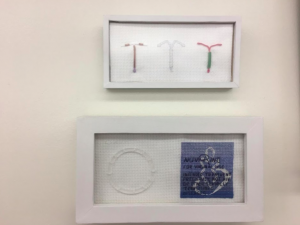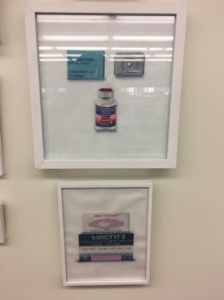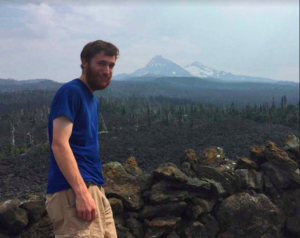
Mar 2, 2018 | Feature |
By Emily Thibodeau Contributing Writer
Artist and activist Katrina Majkut recently visited UMF’s Emery Art center to share her art that “explores social traditions and their impact on civil rights.”

Katrina Majkut utilizes the cross stitching method to accentuate the status and hard work of women in society. (Photos by Emily Thibodeau)
Majkut’s work is on display in the Mantor Library and can be found on the Mezzanine. The series is made up of birth control methods, as well as other products associated with feminism. This is part of a series Majkut has been working on since 2010.
Majkut specializes in cross stitching, a form of sewing in which X-shaped stitches are formed into a picture.
“Cross- stitch is considered a low-end art, which is an unfair stereotype in contemporary art,” Majkut said.
Majkut was picked out of over 40 applicants from to be part of the “Art on Campus” program. Ann Bartges, chair of The Art on Campus Program committee said Majkut was unanimously chosen by the

IUDs and a NuvaRing.
committee as “she does not try to get a specific response, but her goal is to get the conversation going,” as well as the fact that she can publicize “something such as a tampon in her art.”
Majkut got into cross-stit
ching when her mother taught her around age eight because “she was teaching me a part of my Ukrainian heritage.” Part of Majkut’s heritage is to learn skills to run a household at a young age.
“Those roles are extremely physical,” Majkut emphasised. Majkut uses cross stitch as a comparison and to representative to the physical labor expected from women.
Majkut has spent hours, even years working on each cross stitch piece. Majkut’s goal is to be “Intersectionally and medically honest” with her work, adding that, “if I don’t understand an object [medically] I refer to [Doctors].”
One piece discussed in the art talk was a Rape/ Sexual Assault kit cross stitch. “The rape kit opened up my eyes to how violent the process [of filing a report] is,” Majkut said. “I think this is the work that is just a response to who I am as an artist and person.”
A question from the audience was if Majkut had any advice for upcomin

A pregnancy test and birth control. Majkut strives for medical honesty and accuracy.
g graduate art majors. Majkut said to “create a defined schedule for art, block time, start to build an art resume now, get used to talking to people. Rejection is high in this field and the art world is a numbers game.”
Avery Boucher, a freshman at UMF, attended the talk as a requirement for a digital imaging class. Boucher commented, “I think what she is doing is definitely new and different. I think as a feminist she has quite a unique way of expressing herself.”
After her talk, Majkut held a workshop where students could learn how to cross stitch. Bartges said, “Students were surprised by how long it takes” to create a cross-stitch pattern. This gave students an idea on how much work and labor is put into each cross stitch piece.
Majkut has recently written a book called The Adventures and Discoveries of a Feminist Bride: What no one tells you before you say ‘I do’. Majkut’s goal with this book was to “create dialogue around what it mean to be a woman.” The book invites readers to join Majkut’s personal journey through experiences with weddings and opinions on wedding traditions.
For more information on Katrina Majkut, please visit katrinamajkut.com.
Mar 2, 2018 | Feature |
By Nicole Stewart Staff Reporter
Senior Anthropology major Bobbi Morneault has been working on her Capstone Project about the Misconceptions of Witchcraft throughout the school year. As part of her major, Morneault will be sharing her project on Symposium Day, a day where students present semester and/or year long projects throughout campus.
Morneault described Capstone as being akin to a senior thesis. “We have to pick a topic and drum up a research question,” said Morneault.
Morneault’s project focuses on debunking myths about Witchcraft. Morneault believes that misconceptions come from what is presented in popular culture. These misconceptions about witchcraft include associations with the fantastical spells in “Harry Potter,” but that is not what witchcraft actually is.
“Witchcraft itself is a broad umbrella term,” said Morneault. “A lot of people automatically think of Wicca, which is a branch of witchcraft, that is true. But it is not all-encompassing. I would describe Witchcraft as a set of practices that are different from any other religion because it is not religion based.” Rather, Witchcraft is a way to connect to nature and the divine by using magick such as spells and meditative states.
According to Morneault, the project is in the early stages and has been submitted to Dr. Gaelyn Aguilar. After the subject of the project is approved, Morneault will start the research phase. This includes handing out surveys and interviewing people on campus about their understanding of Witchcraft. As a part of the research phase, Morneault is going to ask those in the Witchcraft community about their opinions on the misconceptions.
Morneault said, “What really inspired me to do this was the fact that when people hear that I self-declare myself as a witch, they always think about magic they can see and not magick that you feel. It’s very popular culture versus practical culture.”
Morneault has been a witch for about three years, and includes divination in her practice. “Palm readings, tarot reading. Divination broadly means telling the future. I like to dabble in the arts. I speak to the universe a lot. A lot of self-affirmation on a daily basis,” Morneault said.
Morneault said that she hopes that people who come to her Symposium will learn something that they didn’t before.
“That’s kinda the whole point of Symposium, right? They either reform their knowledge about the subject at hand, or they learn about the subject at hand,” Morneault said.
Symposium Day this year will be on Wednesday, April 25th.

Mar 2, 2018 | Feature |
By Andres Quevedo Contributing Writer

Bryce Neal conducted research over the summer at Yellow Stone National Park. (Photo Courtesy of Bryce Neal)
UMF Geology major Bryce Neal was a part of a research project in Yellowstone National Park during the summer of 2017, working alongside a research team based out of Oregon State University and the University of Wisconsin – Madison. They unraveled the volcanic secrets hidden underneath Yellowstone National Park.
Neal was chosen by the National Science Foundation Research Experience for Undergraduates (REU). REUs are summer programs that give undergraduate students majoring in STEM disciplines the opportunity to be involved with scientific research programs across the country.
The REU program took place from June 2017 to August 2017. For the first two weeks, students, including Neal, were in Oregon doing background research. Then, the students spent the entire month of July doing fieldwork in Yellowstone. After that, they came back to Oregon in early August to analyze their data.
This project involved geophysics, which he had been interested in before he applied for this program.
“You can think of it like taking an ultrasound of the planet,” Neal said.
Thanks to this research, new data has been added to the historiography of volcanic research. Using geophysics, Neal and the research team successfully imaged magma “bodies” at both shallow and deep portions of the Earth’s interior.
“When I say magma bodies, I don’t mean huge, completely liquid magma bodies that you might see in a science fiction film,” Neal said. “The magma bodies we imaged are only partially melted, meaning that they mostly consist of superhot rock and a little bit of magma here and there.”
Neal said, “I applied for the Earth Science REU program at Oregon State University in Corvallis, Oregon, and was accepted in March 2017. Originally, the research project I chose to be involved with was using geophysics to better understand earthquake risk in the Cascadia Subduction Zone.”
In late April, his research mentor notified him that the lab had received funding and a National Park Service research permit to conduct a major project in Yellowstone National Park. “My mentor asked me and my work partner Rebeca if we wanted to be part of the field team, and we both enthusiastically said yes!” said Neal.
The project involved utilizing a geophysical technique called magnetotellurics, which uses solar flares and global lighting activity to measure variations in electric and magnetic fields in the planet’s interior. This allowed the research team to determine how electrically conductive or resistive materials that make up the Earth are. Magma, water, and metals are very conductive, while bedrock is often very resistive.
Neal had displayed his skills in other research programs in the New England natural landscape before his fieldwork in Yellowstone. “During summer 2016, I worked with Dr. Julia Daly on her Maine Mountain Ponds project monitoring high elevation ponds in Maine and New Hampshire. Right now, I’m working with Dr. Douglas Reusch mapping the geology of Saddleback Wind in Carthage, near Mt. Blue State Park,” he said.
This research will undoubtedly contribute to Neal’s career and professional path.
“This research gave me a lot of experience with geophysics, which I would like to pursue in the future whether it be through employment or graduate school,” Neal said. “My coworker and I also got the opportunity to present this research at the 2017 American Geophysical Union Fall Meeting in December, which was an amazing experience.”




